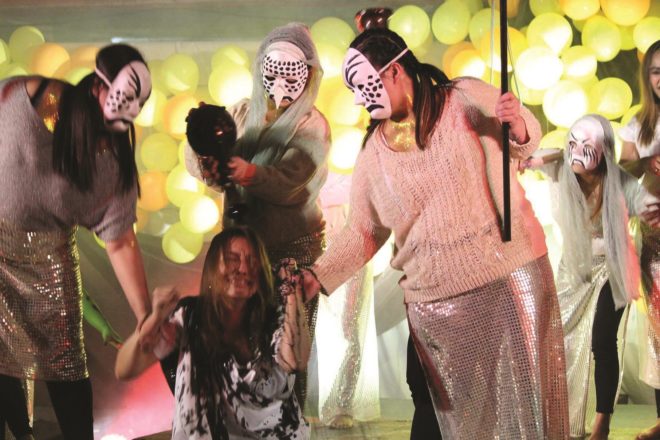
“We won’t say anything more of our sins, we shall perform.
Come be a priest for a while, or let us exhume our sins together.
Get to know your city’s monsters; get to know yours.
Test your faith in the system;
face the mirror.
Go to Church. Go to the people.
Have an encounter with God.”
These lines are taken from a poetic invite by writer-director Angelo Aurelio to his latest play, “The Anatomy of an Octopus Woman (Anatomiya ng Babaeng Pugita),” which featured inmates of the Baguio City Jail (BCJ) Female Dormitory.
The show first ran on June 10-12 at the Baguio Women’s Jail Library, and got a reboot on Nov. 25 at the Bureau of Jail Management and Penology Quadrangle, in a version that was 10 times bigger.
Three of the original cast members rejoined the show as free women—a fact that merited a revamp of some acts, said Aurelio. The cast had also ballooned from 25 to 43, so more could take part in what was now a fruitful aspect of the reformatory program at BCJ. Aside from livelihood trainings, journalism workshops and alternative learning system, performance art is now also included in the prison’s rehabilitation program, allowing inmates to join acting workshops and even earn from the ticket sales of the plays they put up.
“Octopus’” casting mirrored the diversity of the residents of the women’s dorm, said Aurelio.
“I have Muslims, Kapampangans, Visayans in the mix. I have cast members with PhD in Biology, Masters in Education, who are professional musicians, public servants.” The actors’ ages range from 19 to 55.
As real and human
Unlike stock portrayals in TV and film, the inmates are “as human and as real as your aunts and sisters,” Aurelio told the Inquirer.
As in past works with community theater in the Cordilleras, and experimental productions with urban poor kids of Mega Manila in “BaKaTa” (2015) and inmates of the Ilocos Sur Provincial Jail in “Misericordia” (2016), Aurelio’s “Octopus” material sprang from workshops, storytelling sessions and improv activities with the women inmates.
The creative process for “Octopus Woman” involved over 50 workshop takers, plus original songs and poems, narratives translated onstage as scenes and movement pieces, confessions of sexual abuse and other traumatic memories.
“This performance, to them, felt like a portal to a new dimension of freedom. It is therapy, the best substitute for the ‘high,’” said Aurelio.
The acts were complemented by local talents Qasim Khalid and Benjan Natividad of Tanghalang SLU; magician Sidney Caytap; and Tara Natividad of Tam-Awan Art Community. Aurelio and Japanese producer Hiromi Meguro performed as well.
Five nominations
Adding buzz to the rerun were the production’s five nominations in the Aliw Awards this year, including two for Best Performance in a New Concept, care of Meguro and Natividad. The actor-inmates are nominated for Best Performance by an Ensemble, and Aurelio for Best Director in a New Concept. The production is also in the running for Best New Performance Concept.
In the show, each performance represented a part of the Octopus Woman, thus an exploration of its anatomy. Aurelio described the metacharacter as an alpha female, “like an aswang or a manananggal, or the jins and devil women of wintertime in Japan. It is a fairy mutated by the intensity of her pains, of her curses, of her misery.”
The decision to go with an unlikely muse was purely organic, said Aurelio.
In biology, the octopus is related to the pusit (literally, squid). The term denotes people who test positive for illegal drugs. Many in the cast were incarcerated for this offense.
In regular sessions called dugtungan (developing a story through the participants’ spontaneous additions to the plot), narratives of higanteng pugita, pugitang kumukuha ng bata surfaced alongside pusit tales.
Some characteristics of the octopus also parallel characteristics and stereotypes attached to women and female inmates, said Aurelio: “It is cunning, smart. In the Japanese context, the octopus is a symbol of eroticism. It observes and mimics movements. Biologically, it has three hearts, nine brains, eight arms, a skin capable of instant camouflage. It is hermaphroditic. It dies after it gives birth.”
Daring
Staying true to the dark pasts that brought the women together, some acts were daring and unapologetic, but they still made for worthwhile points of discussion for “government workers, academics, workers in the arts and, well, people 18 and above.”
Despite the show’s fantasy elements, Aurelio said one thing that pulled audiences back to reality was the discussion of redemption, both a timely social issue and a familiar existential experience.
“It’s a religious pilgrimage into the self, to discover the humanity of the inmates and how we all are very much like an Octopus Woman,” he said.